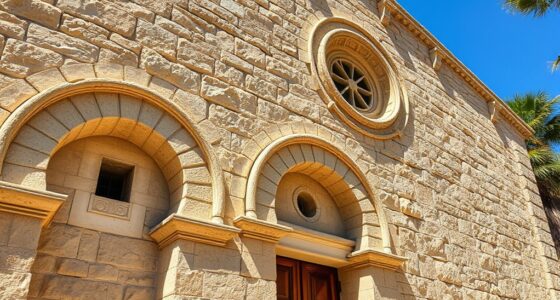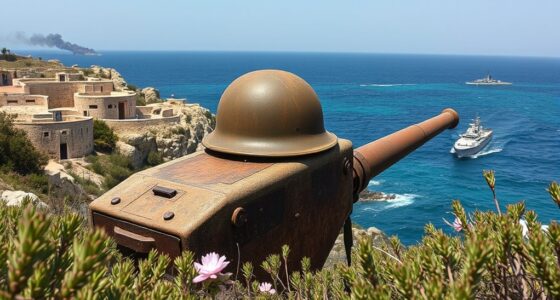Ancient Roman roads in Sardinia formed a crucial network connecting major towns, ports, and inland resources, supporting trade, military movement, and urban growth. Built with durable layered techniques using basalt and stone paving, these roads also included sewer systems for sanitation. Many sections are well preserved or uncovered through excavations, highlighting their strategic importance. To discover how these routes shaped Sardinia’s history and still influence the landscape today, keep exploring.
Key Takeaways
- Sardinia’s Roman roads connected key ports and interior regions, facilitating trade, military movement, and urban development.
- Construction involved layered techniques with basalt or travertine paving, drainage systems, and durable lime mortar.
- Notable routes include the main north-south axis linking Karales (Cagliari) to Turris Libisonis (Porto Torres).
- Archaeological sites like Pont’Ezzu and excavations in Fordongianus reveal well-preserved Roman road remains.
- Modern digital tools and preservation efforts help document, study, and protect Sardinia’s ancient Roman road network.
The Main Routes Connecting Sardinia’s Key Urban Centers
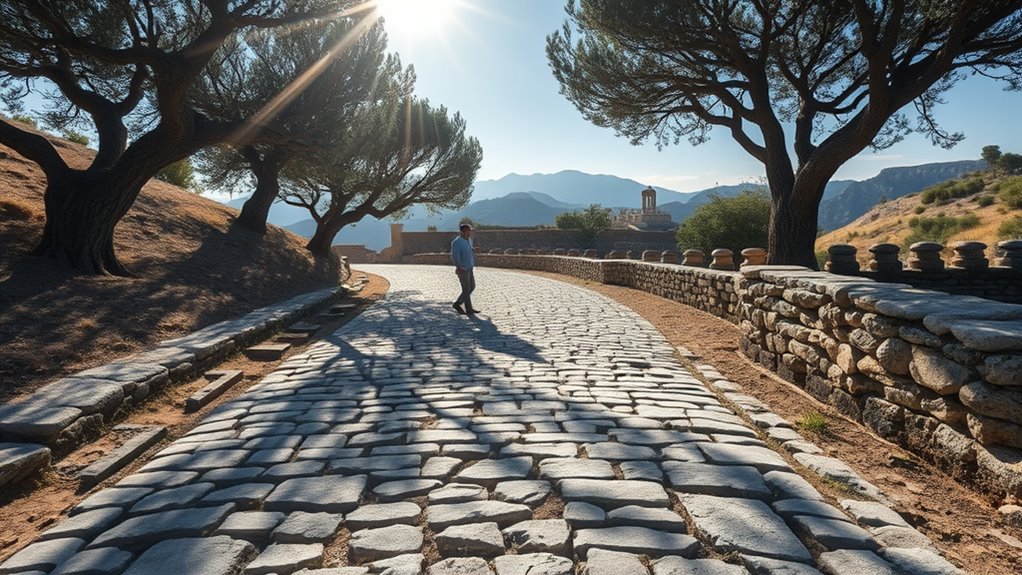
The main Roman route connecting Sardinia’s key urban centers runs from Karales (modern Cagliari) in the south to Turris Libisonis (Porto Torres) in the north, serving as the island’s primary artery during Roman times. This road linked Sardinia’s two major ports, essential for trade and administration, and is marked by milestones with inscriptions like *a Turre*, *a Turre Karalis*, and *a Karalibus Turrem*. It formed the backbone of the island’s Roman road network, facilitating troop movements, economic activity, and connecting smaller settlements. The route roughly follows today’s main infrastructure corridors, highlighting its lasting importance. Continuous renovations until the late 4th century A.D. reflect its indispensable role in maintaining control and fostering connectivity across Sardinia’s diverse regions. Additionally, the enduring significance of this route demonstrates how infrastructure development can influence regional stability and growth over centuries.
Construction Techniques and Materials of Roman Roads
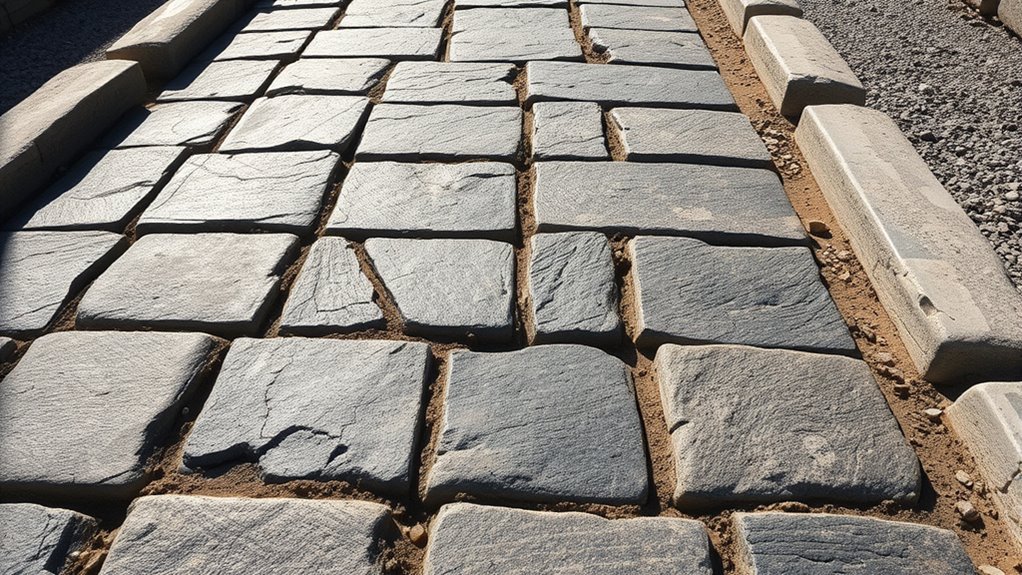
Roman road construction in Sardinia combined careful engineering with resourcefulness, adapting techniques to the island’s diverse landscapes. You start by excavating a *fossa*, a trench that forms the road’s foundation, with depth and width tailored to the terrain. This trench is filled with layers of rubble, gravel, and locally available stones, sometimes topped with sand for leveling and drainage. The base is compacted through *pavire* to ensure stability. Over this, Romans laid a *statumen* of flat stones set with mortar, followed by a *rudus* of coarse lime concrete, then a smoother *nucleus*. The surface features polygonal basalt or travertine paving stones, tightly fitted for durability and water runoff. Drainage ditches and crowned profiles further protect the road, ensuring longevity despite Sardinia’s environmental challenges. Roman engineering standards emphasized precision in laying each layer to maximize the road’s durability and resistance to weathering over time, reflecting their advanced understanding of construction techniques and materials.
The Role of Roads in Sardinia’s Economic and Military Expansion
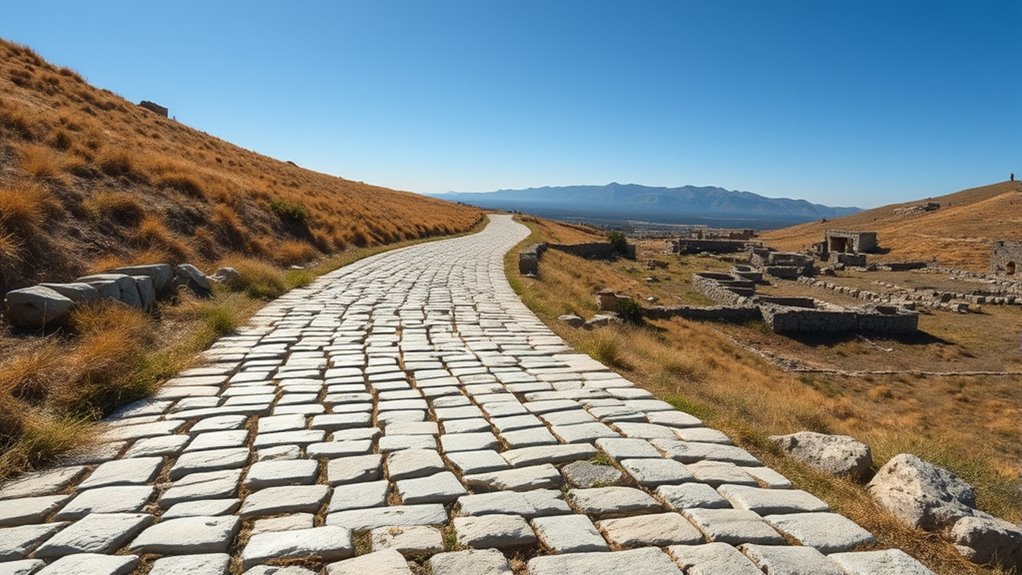
Roman roads in Sardinia served as essential arteries that greatly expanded the island’s economic and military reach. They linked major coastal cities like Cagliari, Porto Torres, and Tibula, boosting coastal trade and exchange. Roads through the interior connected resource-rich areas near the Gennargentu massif and Ulbia, reducing transportation costs and supporting local economies. These routes encouraged settlements and market centers, shaping Sardinia’s economic landscape. Military strategists carefully planned these routes to optimize strategic advantage and facilitate movement across diverse terrains. Militarily, roads allowed rapid deployment of legions, securing coastlines and interior regions. Strategic roads supported swift moves against threats and facilitated logistical support at outposts. They also secured key harbors, strengthening naval dominance. Overall, these routes enabled efficient administration, resource exploitation, and population growth, laying the foundation for Sardinia’s integration into the Roman economy and empire.
Archaeological Discoveries and Preserved Road Sections

You can observe remnants of Roman roads in Sardinia that reveal their construction techniques, like basalt block pavement and stone bridges. Excavations have uncovered these sections, often alongside other archaeological features, confirming their historical importance. Studying these preserved segments helps you understand Roman engineering and how they integrated roads into the island’s landscape. These findings provide valuable insights into the scale and precision of Roman infrastructure projects in Sardinia. Additionally, the construction techniques used reflect the advanced engineering skills of the Romans and their ability to adapt to diverse terrains.
Visible Road Remnants
Numerous visible remnants of ancient roads still crisscross Sardinia, offering a tangible link to its imperial past. Major routes, like the one from Portu Tibulas to Caralis and the western coast road from Nura to Turris Libisonis, leave clear traces near towns such as Posada, where side roads once connected ports to inland settlements. Some paths align with modern roads, especially along the coast and near Gennargentu, making their routes easy to trace. You’ll notice basalt block pavements, often irregular and worn by centuries of use, like the 10-meter stretch in Fordongianus. Many remnants are integrated with archaeological parks or ruins, revealing how roads connected temples, baths, and settlements. These visible sections provide a vivid glimpse into ancient Sardinia’s bustling Roman infrastructure. Roman roads in Sardinia were constructed with durable materials like opus quadratum, ensuring their longevity and continued visibility today. Additionally, ongoing excavations help uncover more archaeological discoveries, shedding light on the extent of Roman engineering in the region.
Construction Techniques
Archaeological excavations in Sardinia have revealed sophisticated construction techniques that guarantee the durability and functionality of ancient Roman roads. These roads were built with multiple layered structures designed for strength and drainage. The subsurface, called statumen, used flat or fist-sized stones up to 24 inches thick. Above that, a rudus layer of pottery shards or gravel with lime mortar, about 9 inches thick, provided stability. Next came a nucleus layer of compacted sand, gravel, and lime concrete, roughly 12 inches thick. The top layer, summum dorsum, featured large flat stones set in lime mortar, curved for drainage, and about 6 inches thick. Roads included drainage ditches, cambered surfaces, and durable paving stones, all adapted to Sardinia’s diverse terrain for long-lasting, strategic infrastructure. These construction methods demonstrate the Romans’ advanced engineering skills and their emphasis on creating roads that could withstand seismic activity and heavy use over centuries. Additionally, the use of layered structures was essential in ensuring the roads’ longevity and resistance to environmental challenges.
Archaeological Excavations
Have you ever wondered what remains of ancient Roman roads in Sardinia can tell us about their construction and use? Archaeological discoveries reveal fascinating insights. In 2009, a 1st/2nd-century AD road section was uncovered on via Vittorio Veneto in Fordongianus, showing irregular basalt blocks worn by carts. Excavations also reveal how Roman roads connected sacred sites like Nuragic and Punic structures near Tharros, alongside urban layouts from Phoenician and Roman periods. Notable finds include well-preserved basalt paving in Fordongianus and Roman bridges built with local stone, such as Pont’Ezzu near Mores. These excavations highlight roads’ roles in facilitating trade, communication, and military control, integrating with civic and religious sites, and revealing advanced engineering and urban planning that shaped Sardinian history. The roads’ carefully constructed basalt slabs and sewer systems demonstrate the Romans’ sophisticated approach to urban infrastructure and sanitation, which was crucial for maintaining a thriving city. Additionally, the contrast ratio of the preserved sections helps archaeologists understand the durability and design choices in Roman road construction.
Impact of Roman Infrastructure on Urban Development
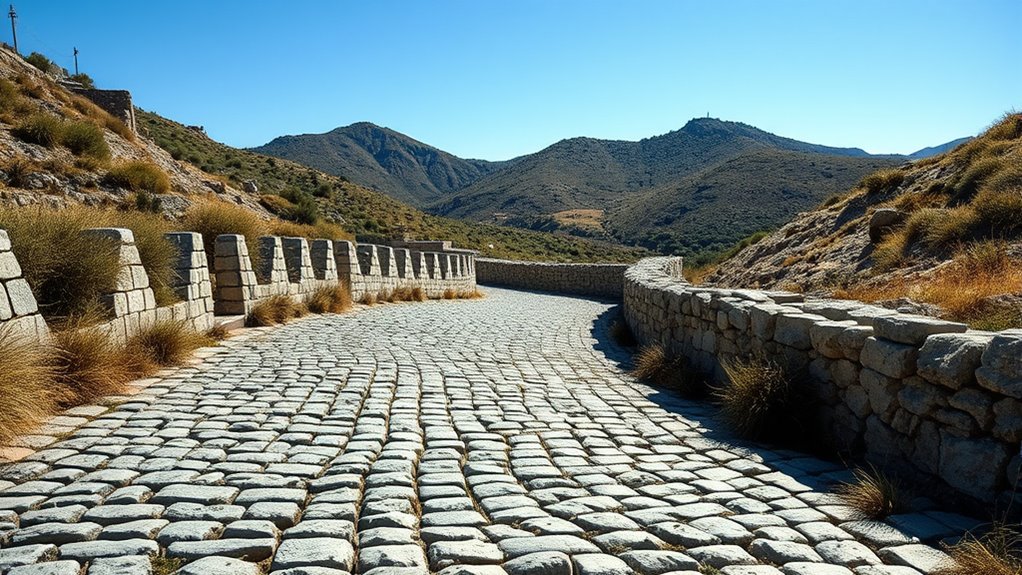
Roman roads in Sardinia profoundly shaped urban development by integrating infrastructure with city planning. You notice paved basalt slabs covering sewer systems, showing how roads and sanitation worked together. Main roads, 3–5 meters wide, divided cities into large, organized quarters, while narrower alleys, or ambitus, subdivided these areas into smaller blocks. Sewer systems aligned with the roads, draining waste from alleys to the sea, reflecting advanced urban sanitation. Roads facilitated long-term growth by encouraging settlement clustering and denser infrastructure, boosting economic activity. Cities on or near roads experienced greater population increases. Roman roads also linked urban centers to rural and coastal areas, supporting trade and commerce. Their durability and integration with urban services laid the foundation for sustainable, organized cities that influenced future urban patterns. Roman roads served as critical infrastructure that not only improved transportation but also supported the development of complex urban systems. This integration of infrastructure and city layout demonstrates how Roman engineering contributed to the urban development process in Sardinia.
Strategic Significance of Sardinian Roads in the Roman Empire
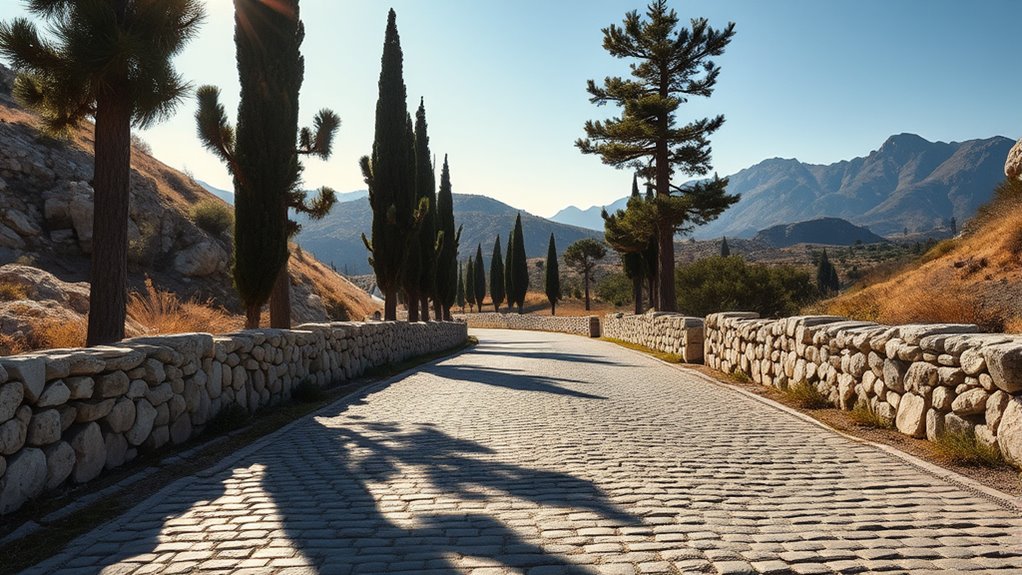
Sardinian roads held a critical strategic role within the Roman Empire by enabling swift military mobilization and securing control over the island’s territories. The network allowed rapid troop movements, strengthening Sardinia’s defensive and offensive capabilities. Major roads connected key coastal and inland centers, ensuring efficient logistics and communication. Bridges like Pont’Ezzu facilitated strategic crossings essential for troop deployment and supply lines. The concentric road design, with north-south arteries, linked Sardinia to Rome and other imperial centers, emphasizing its importance in imperial security. These roads also supported Sardinia’s role as a crucial military base and naval station in the Mediterranean, helping control sea routes and supporting campaigns. Roman engineering techniques were employed in the construction of these roads, ensuring durability and effectiveness in the challenging Sardinian terrain. Additionally, the sophisticated infrastructure underscored the Roman commitment to strategic control and long-term stability in the region.
Modern Heritage and Preservation of Ancient Road Networks
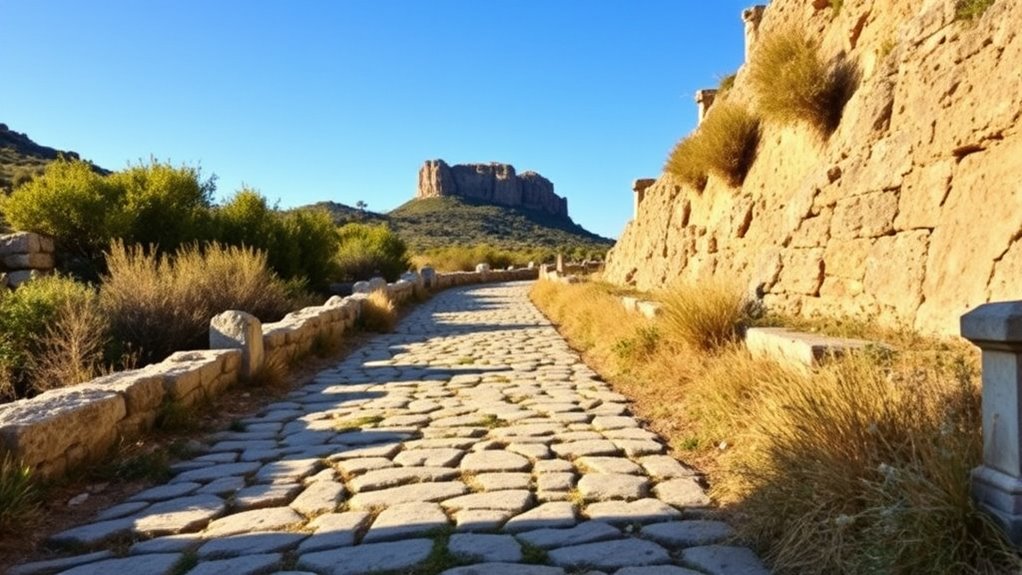
You can explore how preservation efforts protect Sardinia’s ancient roads, from archaeological sites like Nora to well-preserved bridges such as Pont’Ezzu. Digital documentation plays a key role in safeguarding these structures and sharing their history with a wider audience. By supporting these initiatives, you help guarantee that Sardinia’s Roman infrastructure remains a essential part of its cultural heritage. Efforts to map and digitally reconstruct the roads ensure their stories are preserved for future generations and accessible to researchers worldwide.
Preservation Efforts and Sites
Preservation efforts in Sardinia focus on safeguarding the island’s ancient road networks from natural deterioration and human interference. Near Spiaggia Su Porto, remnants of Roman roads between Bithia and Nora remain visible, integrated with local trails like Strada Romana, with well-preserved paving sections and some structural remains. Coastal erosion and water barriers pose ongoing challenges, prompting protective signage to limit coastal activity near archaeological sites. In Fordongianus, 2009 excavations uncovered a 1st/2nd century AD Roman road beneath via Vittorio Veneto, with basalt blocks exposed for public education, situated within a broader archaeological landscape. The Pont’Ezzu bridge in Ozieri and the Roman bridge at Porto Torres exemplify efforts to safeguard significant infrastructure, with ongoing maintenance to ensure structural stability. Archaeological parks further facilitate coordinated preservation of roads alongside other ancient remains. Additionally, IRA investment strategies can provide funding avenues for preservation projects, highlighting the importance of financial planning in cultural heritage conservation.
Digital Documentation and Heritage
Digital documentation plays a crucial role in preserving Sardinia’s ancient Roman road networks by creating detailed, accurate records that support ongoing conservation efforts. You leverage advanced techniques like lidar-based mobile mapping, 360° cameras, and high-resolution digital photography to produce precise 3D models and high-density point clouds. These models enable heritage professionals to monitor deterioration, plan restorations, and simulate historic conditions without physical interference. Using GNSS and SLAM technologies, field surveys are faster and more accurate, ensuring extensive digital archives. Linking this data to GIS supports maintenance and decision-making. Successful projects, such as documenting the 12 km Appian Way segment in Rome, serve as models adaptable to Sardinian roads. Digital preservation therefore safeguards the region’s rich history and enhances scholarly and public engagement.
Frequently Asked Questions
How Do Roman Roads Influence Modern Sardinian Transportation?
You see that today’s Sardinian transportation largely follows the paths set centuries ago. Modern roads and highways align with ancient routes, emphasizing direct, strategic connections. This legacy influences where towns develop, how goods move, and even military logistics. The straight, durable Roman roads still shape transportation, ensuring efficient travel and connectivity. By understanding this history, you realize how past infrastructure continues to guide Sardinia’s modern transport network.
Were There Any Unique Construction Features Specific to Sardinian Roads?
What makes Sardinian roads stand out? You might think they hold secret, unique features, but they follow the classic Roman blueprint. You’ll see layered stones, gravel, and lime mortar—standard everywhere. Drainage systems, cambered surfaces, and stone bridges mirror imperial practices. Sardinian roads, like a well-rehearsed symphony, adhere to universal Roman engineering, showing no distinct local tricks—just reliable, time-tested craftsmanship across the empire.
What Evidence Links Roman Roads to Nuragic and Punic Sites?
You see that Roman roads in Sardinia often connect or run near Nuragic and Punic sites, indicating reuse of sacred or strategic locations. Excavations reveal stratigraphic contact and proximity, suggesting Romans repurposed earlier infrastructure and pathways. Foundations of Punic temples lie beneath Roman constructions, and Roman bridges follow ancient routes, showing continuity. While roads rarely overlay Nuragic remains directly, materials and site placement highlight a layered, interconnected network built on older cultural landscapes.
How Did Roman Roads Impact Local Sardinian Cultures and Languages?
You see, Roman roads markedly influenced Sardinian cultures and languages by increasing connectivity, which led to urbanization and the spread of Roman customs. As you travel along these routes, you notice how Latin became dominant, especially in cities, reducing indigenous language use. Roads also promoted cultural exchange, blending local traditions with Roman practices, shaping social structures and communication patterns that persisted long after Roman rule, leaving a lasting legacy.
Are There Ongoing Excavations Revealing New Roman Road Sections in Sardinia?
You’re curious if new Roman road sections are still being uncovered in Sardinia. Excitingly, ongoing excavations happen regularly, often during urban renewal or infrastructure projects. You might not see full roads yet, but archaeologists carefully reveal and preserve fragments beneath modern surfaces. These discoveries, sometimes hidden beneath busy streets or industrial zones, continue to reshape your understanding of Sardinia’s ancient landscape—proving that history’s layers are still waiting to be uncovered.
Conclusion
As you walk along Sardinia’s ancient Roman roads, you glimpse the empire’s enduring legacy, a monument to ingenuity and ambition. These routes, like veins in a living body, once fueled commerce and conquest, shaping the island’s destiny. Their preserved stones whisper stories of resilience and grandeur—reminding us that history isn’t merely in the past but woven into the very paths we walk today. Truly, these roads are Sardinia’s timeless heartbeat.


